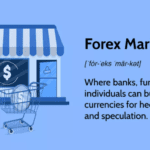Introduction to Forex Trading: A Beginner’s Guide
Forex trading, also known as foreign exchange trading or currency trading, is the process of buying and selling currencies in the global marketplace. It is the largest and most liquid financial market in the world, with a daily trading volume exceeding $6 trillion. Whether you’re looking to trade as a hobby or pursue it as a profession, understanding the basics of forex trading is essential. This guide will introduce you to forex trading and provide you with the foundational knowledge needed to get started.
What is Forex Trading?
Forex trading involves exchanging one currency for another in order to profit from changes in exchange rates. Currencies are traded in pairs, such as EUR/USD (Euro/US Dollar) or GBP/JPY (British Pound/Japanese Yen). The value of a currency pair fluctuates based on economic, political, and market factors.
Unlike stock markets that have a central exchange, the forex market operates 24 hours a day through a decentralized network of banks, brokers, and financial institutions. The major forex trading centers are located in London, New York, Tokyo, and Sydney.
Key Concepts in Forex Trading
Before diving into forex trading, it’s important to familiarize yourself with key concepts:
1. Currency Pairs
Forex trading is conducted in pairs. Each pair consists of a base currency (first currency) and a quote currency (second currency). For example, in the EUR/USD pair:
- EUR is the base currency
- USD is the quote currency
If the exchange rate of EUR/USD is 1.2000, it means 1 Euro is equivalent to 1.20 US Dollars.
2. Pips and Spreads
- Pip (Percentage in Point): A pip is the smallest price movement in the forex market. For most currency pairs, a pip is equal to 0.0001.
- Spread: The spread is the difference between the bid price (buying price) and the ask price (selling price). It represents the cost of trading and varies depending on market conditions.
3. Leverage and Margin
- Leverage allows traders to control a larger position with a smaller amount of capital. For example, with 1:100 leverage, a trader can control $10,000 with only $100.
- Margin is the amount of money required to open a leveraged trade. Higher leverage increases potential profits but also increases risk.
4. Trading Sessions
The forex market operates 24 hours a day in different trading sessions:
- Asian Session: Tokyo and Sydney markets (low volatility)
- European Session: London market (high volatility)
- North American Session: New York market (high volatility)
The most active trading periods occur when sessions overlap, such as London-New York.
How to Start Trading Forex
1. Choose a Reliable Broker
Selecting a reputable forex broker is crucial for success. Consider the following factors:
- Regulation (e.g., FCA, CFTC, ASIC, or CySEC)
- Trading platform (e.g., MetaTrader 4/5, cTrader)
- Spreads, fees, and commissions
- Customer support and educational resources
2. Open a Trading Account
Most brokers offer different types of accounts, such as:
- Demo Account: A practice account with virtual money
- Standard Account: A real trading account with moderate spreads
- ECN Account: Direct market access with low spreads and commissions
3. Learn Technical and Fundamental Analysis
Successful forex trading requires a combination of technical and fundamental analysis:
- Technical Analysis: Uses price charts, indicators, and patterns to predict market movements.
- Fundamental Analysis: Examines economic data, interest rates, and geopolitical events that affect currency values.
4. Develop a Trading Strategy
A good trading strategy includes:
- Risk management (e.g., stop-loss, take-profit orders)
- Entry and exit rules
- Position sizing
- Psychological discipline
5. Start with a Demo Account
Practice with a demo account before risking real money. This allows you to test strategies, understand market conditions, and gain confidence in your trading decisions.
Final Thoughts
Forex trading can be a profitable endeavor, but it requires knowledge, discipline, and a solid strategy. Beginners should focus on learning the basics, practicing on a demo account, and gradually transitioning to real trading. By understanding market trends, managing risks, and staying patient, you can improve your chances of success in the forex market.
Are you ready to start your forex trading journey? Let us know your thoughts or any questions in the comments below!



